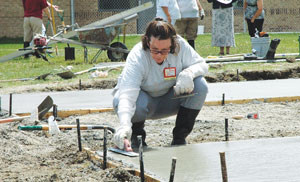University Communications and Marketing
MSU Billings prison pathways project gets new partners, federal funding
September 29, 2010
Contacts:
Kim Gillan, Workforce Development Specialist, 896-5878
Dan Carter, University Relations, 657-2269
‘New Path, New Life’ will focus on reentry strategies with community, state partner
MSU BILLINGS NEWS SERVICES — A Montana State University Billings program that helps prepare women prisoners for the world of work and education has expanded with new community partners and has gained national attention.
That attention, in turn, has yielded federal grant support to help develop new re-entry pathways for female prisoners once they complete programs.
The U.S. Department of Justice recently awarded a $165,184 grant to be used by the Billings Area Reentry Task Force and MSU Billings to implement collaborative initiatives that help women released from the Montana Women’s Prison transition into new lives.
The grant will be matched by community partners and the Department of Corrections to develop and deliver the programs.
 Kim Gillan, workforce development specialist with MSU Billings who works on the grant
from the university’s downtown campus, said the competitive grant was sought through
the Montana Department of Labor and Industry as a way to expand the academic and workforce
training done in the prison into the community.
Kim Gillan, workforce development specialist with MSU Billings who works on the grant
from the university’s downtown campus, said the competitive grant was sought through
the Montana Department of Labor and Industry as a way to expand the academic and workforce
training done in the prison into the community.
“I think this is affirmation that what we’ve been doing is headed in the right direction,” she said.
The new initiative is builds on the success of the MSU Billings “Pathways to Self-Sufficiency” program. A demonstration project funded by $600,000 from the U.S. Department of Justice and a partnership with the Montana Department of Corrections and the Montana Job Service, the program offers college-level course and workforce training inside the prison walls.
Women who qualify for the program take courses in family economics, math, writing, reading, philosophy, carpentry, construction, small business planning, graphic design and concrete fundamentals. They also can get involved in programs that offer skills assessment and career planning. In order to graduate, inmates must complete 124 hours of coursework in the curriculum “core” of math, reading, personal work skills development and writing, and must complete at least two electives. MSU Billings faculty and community members are hired to teach the classes and serve as mentors. Since its inception about two years ago, 75 inmates have participated in the program.
The program is designed to give women marketable skills they can use to support themselves and their families once they are released. The federal grant, handled by the Montana Department of Labor, will make the reentry process easier.
“We are proud to be a part of this partnership. Finding a job can be challenging enough once you’ve been incarcerated; this program will give participants the tools and skills they need to re-enter the workforce,” said Labor Commissioner Keith Kelly.
The goal of the new demonstration project — called “New Path, New Life” — is to reduce the recidivism rate in program participants. The project relies on their existing partnerships with a variety of Billings social service, educational and workforce organizations.
Gillan said the Billings Area Reentry Task Force took root over 12 months ago when MSU Billings began meeting with representatives from Passages, the Montana Women’s Prison, the Department of Parole and Probation and Montana Job Service to discuss the needs for female offenders re-entering the community. The group is modeled after similar successful programs in larger cities and states across the nation.
There are currently 14,000 people under the supervision of the Montana Department of Corrections throughout Montana. Of those, about 1,500 are in the Billings region; 354 or 24 percent are female.
“Recognizing this geographic concentration, we felt that it was imperative to explore ways to improve coordination among both the public and private support organizations,” Gillan said.
A key element of the new project is to determine at what point reentry planning should begin, Gillan said. The average length of stay at the women’s prison is less than two years and assessments done upon entry can often identify “needs” that the prison should address to improve their chances of being successful upon reentry.
The reentry task force will focus on three main areas: Employment, housing and relationships. With MSU Billings taking the lead, the demonstration project will work with both public and private groups with a targeted group of female offenders to see what types of interventions work best.
“We need to figure out how to operate like a relay race,” Gillan said. “That is, figure out a better way to pass the baton, avoid dropping it and make sure the offender reaches the finish line with a successful transition back to the community.”
Success will result in improved public safety as well as cost savings, she noted. The cost for incarceration of a female offender is over $100 a day, but less than $10 a day when the offender is under community supervision.
The new grant will provide both financial and technical assistance for the reentry task force. The group hopes to develop a model that can be used in other communities across Montana with an overall approach much like “wrap-around services” used for Montana children with mental health needs.
The group will also look for ways to share, pool or otherwise leverage resources in order to be sustainable in the long run.
For more information on the Billings Area Reentry Task Force or the “New Path, New Life” initiative, contact Gillan at 896-5878.
PHOTO ABOVE: An inmate at the Montana Women’s Prison does concrete work at the prison as part of the workforce training provided by Montana State University Billings.
